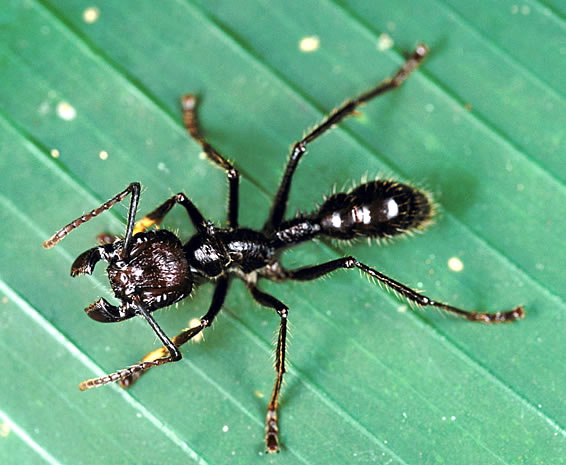Paraponera
From Wikipedia, the free encyclopedia
[Photo] Bullet Ant (Paraponera clavata). Source: www.afpmb.org/pubs/Field_Guide/field_guide.pdf (US AIRFORCE)
Paraponera is a genus of ant consisting of a single species, the so-called bullet ant (P. clavata), named on account of its powerful and potent sting, which is said to be as painful as being shot with a bullet. It is called by the locals, "Hormiga Veinticuatro," or "24-hour ant", from 24 hours of pain that follow a stinging. The bullet ant inhabits Atlantic coastal lowland rainforests from Nicaragua southward to the Amazon basin. Workers are 18-25 mm long and look like stout, reddish-black, wingless wasps.
General facts
The pain caused by this insect's sting is purported to be greater than that of any other Hymenopteran, and is ranked as the most painful according to the Schmidt Sting Pain Index. It is described as causing "waves of burning, throbbing, all-consuming pain that continues unabated for up to 24 hours". A paralyzing neurotoxic peptide isolated from the venom is poneratoxin. The Paraponerinae is a primitive subfamily and their stings are morphologically similar to those of some solitary wasps and hence are often most severe, being intended as multi-purpose defensive tools rather than the more specialized weapons of more advanced ants.
Paraponera is predaceous and, like all primitive poneromorphs, does not display a great deal of polymorphism. Colonies consist of several thousand individuals, and are usually situated at the bases of trees, workers foraging arboreally in the area directly above the nest for insect prey and nectaries, often as far as the upper canopy. The genus is found along the Atlantic coast of South and Central America, including Costa Rica, and coincides with the range of the closely related Dinoponera.
Bullet ants are used by some indigenous people in their initiation rites to manhood (Bequaert, 1926). The ants are first knocked out by drowning them in a natural chloroform, and then hundreds of them are woven into sleeves made out of leaves, stinger facing inward. When the ants come to, boys slip the sleeve down onto their arm. The goal of this initiation rite is to keep the sleeve on for a full ten minutes. When finished, the boys' arms are temporarily paralyzed because of the venom, and they may shake uncontrollably for days. The only "protection" provided is a coating of charcoal on the hands, supposedly to confuse the ants and inhibit their stinging. To fully complete the initiation, however, the boys must go through the ordeal a total of 20 times over the course of several months or even years.
http://en.wikipedia.org/wiki/Paraponera
| The text in this page is based on the copyrighted Wikipedia article shown in above URL. It is used under the GNU Free Documentation License. You may redistribute it, verbatim or modified, providing that you comply with the terms of the GFDL. |
|

